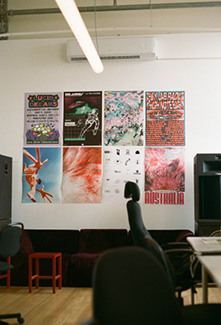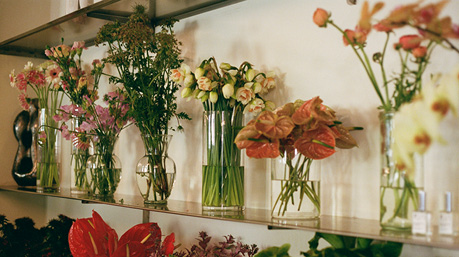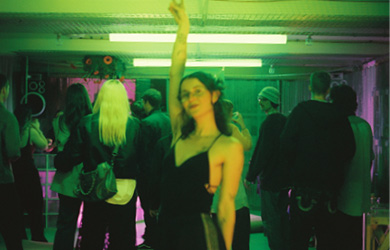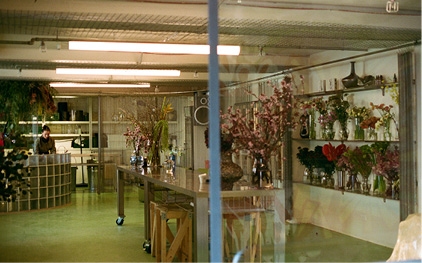
running a nightclub with a partner. I was choosing a very intense lifestyle. Lots of drugs, lots of late nights. I’m really glad my spirit was strong enough to notice the need for change, because I did lose quite a few friends to that lifestyle.
Through gardening, I became interested in plants. I then found floristry and realised it was a pretty untapped art form at the time. This was like 12 years ago. It definitely wasn’t what it is now, and I feel like I was able to be part of that movement in Melbourne.”
After getting into floristry, what was your career path like? Were you freelancing all the way, or did you also work in stores?
“I’ve worked in so many. My favourite was working at a hospital florist. It’s really tacky and classic, with pink bears and nappy cakes, baby nappies that you make into this cellophane cake. The contrast between what I wanted to do with floristry and working there was really good for me. At St. Vincent’s Hospital, I got to deliver flowers for incredible reasons. That’s when I realised the spiritual and meaningful side of floristry. You’re there for births and deaths. They’re some of the biggest moments in this life, you know?
After that, I freelanced a lot for big event companies over the summer. My main one was Tori Allen. We’d all receive the design for the day, get split into groups and be allocated vans in this huge warehouse. I don’t think I’ll ever want to go to that scale ‘cause I might lose my artistry in there somehow, but it’s taught me how systematic mass delegation works and I apply some of that into staff management now.”
The hospital florist reminds me of the workshop you did earlier this year, the one about death?
“Yes! We did a death workshop (Life in Bloom: Floral Design For Farewells) through Melbourne Design Week. There is a category called “death art” which I didn’t know was a thing. It was so beautiful. We had people in here who had lost their children and people who were funeral directors. It was a very special event for me.”
After all these experiences, how did Xflos come to be?
“I always wanted to work for myself. As well, working in those deliberate, corporate environments left me bursting at the seams. Being part of the music and dance culture in Melbourne at the time, with friends who were DJs, I feel the urge to bring flowers into those spaces. Like what about exhibitions? What about festivals? What about things that are relatively more alternative? 6 or 7 years ago, my best friend and I were invited to do a dance party for Wax’o Paradiso. From there, it was festivals like Inner Varnika, Hopkins, and more. Xflos started with us doing alternative techno parties.
I was a sex worker at the time, so the X represents the money I put into this business from that work. I’ve always been drawn to the under-ground - like nightclubs, brothels, etc - because it’s very much where I came from and I want to have flowers that were different in that way. To me, many flowers can be very polished and prissy, but nature’s grotesque, wild, surprising and shocking too. I wanted to make things that were beautiful but provocative.“
Like embracing the chaotic side as well as its beauty.
“Yeah, thank you, chaos is a good term.”

“Monotype” is a series of conversations with artists in meaningful spaces,
offering a glimpse into their one-of-a-kind piece of mind.
In the chic, soft basement beneath Perry St Building in Collingwood Yards,
I sat down with Kayla for the first Monotype episode. We’d just come from a back-to
-back meeting, so the air was already well warmed with chat.
Kayla is a floral artist and the founder of Xflos, a florist based in Collingwood. They not only serve beautiful flowers to locals and brands, but also host events and workshops. The space, now almost a year old, is the first official home of Xflos. It was designed and built by her partner, Henry of Wingnut Studio. Kayla and I got to know each other through Stay Soft Studio, the creative co-working space she co-founded, which also runs monthly night markets in the art precinct.
It was a Tuesday afternoon when we met. Flowers had just been set up fresh for the week. Staff moved around while soft music played in the background.

Thank you so much for your time. Can we start with a brief introduction of yourself?
”My name is Kayla Moon. I’m 30 years old, born in 1995. I’m based in Naarm, in so-called Australia.”
When and how did your floral journey begin?
“It started from gardening, and gardening started from a need to re-connect with myself. At the time, I was super young at 17 or 18,



What tends to inspire your floral design? Is it co-lours, shapes, or experiences?
“I tend to move through seasons and moods. Sometimes it’s all about colour, then I’ll shift to shape and form, then I’m just obsessed with a heap of lines. Even astrology plays a part. I didn’t even choose it; it just came. At the moment, I’m more motivated by organic forms.”
Kayla pointed to a vase at the other end of the table.
At first sight, to me, it evoked the transition from silent winter to spring, when things begin to be reborn.
“For instance, over there is this twisted willow, its natural form is dropping down. I’m obsessed with honouring that. I want to challenge myself and see how three simple organic forms can work together without manipulating them. Because I spend so much of my time manipulating things and trying to shape them.”
To embody these inspirations, what is your creative process like?
“It depends. For clients, we have a consultation process where we take down all the design and logistical notes - venue, purpose, budget, color scheme, all of that. Besides meetings, we’ve got a group chat where we’re always sending inspos. I encourage the girls and myself to look at artists in different mediums we’re interested in at the time. For example, why do you like the shape of the key chain or the music you’ve been listening to? From there, we would design based on all of that.
Whereas, if I’m creating for myself or for us, which I try to do once a quarter, it’s really free. I’ll put a few images on paper or in software, and just flow.”
Do you sketch as well? Or how do you visualise?
“Yes, mostly with InDesign. We use flower stickers and then collage them. I’ll show you.”
Kayla opened her laptop and showed me the neatly organised folders, a library of flowers in different colours they use. With it, they can quickly grab the assets and piece arrangements together in the deck.
That’s actually so handy. It takes a lot of effort when you have to dig for them every time. In video creation, too, mak-ing references clear is crucial to help the clients or investors picture the work.
“Exactly. And now the girls are designing as well, it has to be. Also, because people, for some reason, can’t picture flowers.”
Steph, the head florist, nodded in agreement while arranging blooms. We all laughed.
“I used to use only reference photos or drawings ages ago. It was such a waste of time because you’re constantly explaining yourself. This seems to be the best way because people can know exactly what it’s going to look like.”
As someone who has been dedicated for so long, have you ever fallen out of love with floristry?
“Absolutely. Halfway through the 6 years of running my own business, I hit that wall. When I was learning and working, I was obsessed and hyper-fixated for years. I couldn’t be a passenger princess without figuring out how I was going to design every single tree or shrub into some-thing. The whole world changed.
But midway, I was so worn down by logistics, bureaucracy, and finances. We’d been through lockdown and I was in my Saturn return. I was like, “I’m so done. I don’t want to fucking do this anymore.”
Persevering through that is so rewarding, though. I had to throw everything at the wall, “Do I want to be a nurse? A sex therapist? What do I want to do?” I looked at all these options and reminded myself, “Chill out. You’re still young. You have time.” I could always change my career later. I’ve built this thing and it deserves to reach the next stage. Growing pain, basically. One of my best friends who is in birthwork always says, “You can’t expand without contracting.”
Is there anything lately that makes you feel curious or joyful in floristry?
“What mainly excites me now is using floristry as a vessel to navigate and implement more community, via workshops and through what you’re doing here. To surround people with odd nature and beauty and create a community around it. To me, it becomes less visual and more social. When I was younger, I was obsessed with ‘being an artist’. I feel like I’ve achieved that - showing my work at *NGV* and other places. Now I still love making something beautiful, but it doesn’t satisfy me deeply. It satisfies Steph deeply, so she does a lot of that now. I’ve passed it on!”

It’s like your flowers transformed into connections and your focus shifted alongside your growth. Community is such a huge part of you now. For the time we’ve known each other, you’ve been like a big sister to those around. What inspired you to build Stay Soft Studio and now FlowerClub?
“Thanks hun, that’s so nice. I grew up in a strong community, raised in sin-gle-mum hippie communities where everyone helped each other. If someone didn’t have a place to live, they would sleep on the couch and someone would bring food over. I think that conditioned me to be this way. Plus, I think it’s
also my nature as an Aquarius to be very humanitarian and caring. I love facilitating spaces for people. Since I was young, I wanted big spaces to do that. And now I’ve got multiple. It’s great!”
We paused as Kayla chatted and said goodbye to the girls coming in for the bouquet. I snapped a photo for them. The florist felt like a safe cave, where everyone is welcomed like a friend. I adore moments like this; this feels like the essence of the community we’re talking about.
What does ‘community’ mean to you in the context of your creative journey?
“Community is having long-lasting relationships with a diverse range of people, in which you can actually rely on each other, not just in easy times but in hard ones.
Most of my friends are small business owners or artists. They all lend each other a hand when things feel heavy, or help each other move stuff when it’s annoying. Community isn’t just this fun and happy thing where a group of friends hang out. It’s going that extra mile with shared resources, values, ethics, and asking, ”How do we exercise and share these so we can all get better?”
Totally! I love how many community-based events and platforms are built with good intentions. But sometimes I feel like I have to be a certain way to be enough or accepted, maybe due to insecurity too.
“I know. I’ve had these two beautiful queer neurospicy people here on Saturday night, and they were so fucking cute. They came to FlowerClub dressed in rainbow colors and gerberas. They told me this is the safest place they feel when they go dancing. And that’s fucked up. It’s such an important testimonial to hear, because that’s all I’ve really ever wanted to do.”
That’s so nice to hear. Balancing inclusivity and exclusivity is hard.
“As a bisexual, I’ve been through phases when I go to lezzie communities and don’t feel very welcome. I think we need selective spaces so that people can enjoy the nature and nurture/conditioning of people like them, especially for marginalised communities. Exclusivity is important, but not when it extends to full exclusion or judgment - we’re better than you or you’re not cool enough - that’s only going to divide us more. We need everyone represented. How else do people learn if they’re never exposed to diversity?
For me, it’s about creating a code of conduct for socially and culturally appropriate environments, where minorities and marginalised people are the platform. If others want to come through, they have to respect the space of those people. That’s something I’ve had to work on for years. I was once called out for racism, too. I had to do the learning and face the ramifications I hadn’t understood at the time.”
With many spaces and events to manage, how do you prioritise self-care?*
“I spend one full day a week in bed. Not just lying there. I’ll do tarot, gua sha, put on the washing and maybe have a bath. It’ll be all to myself. Sometimes even two, if possible. I go pretty deep into non-verbal resets. I’ll tell my housemates: I’m not verbal today.”
You mentioned giving yourself a full day to reset. On the other side, social media demands constant presence. How do you navigate its role in shaping *Xflos* and your creative practice?
“Honestly, don’t know how I would have navigated launching a business without social media. Starting the Xflos Instagram motivated me to keep going. When you’ve built an audience, you have to show up. It’s like discipline. Constant content creation is a big part of how we connect with people, but I also need to make sure it’s not my only channel for creativity, especially now that my girls are taking a lot of design.
I feel like through social media, you get to see so many creative and useful resources while building connections, but it’s also hard to avoid comparison and insecurity. Do you ever feel that?
“Hell yeah. I’ve gone through different seasons with social media. In lockdown, especially, I found it really hard. I’ve gone months without it and had all of these really big discourses. Now, I treat it more creatively and community-focused.
But I control my hours. That’s been the biggest help this year, figuring out how to look like I’m always online without being online. If someone’s presence is triggering, I mute them. Now my feed is just closed friends and people who inspire me. My explore page is memes and news.”
Reading your posts often reassures me that other people feel the same way. You’re very honest in sharing your thoughts publicly.
“I’m glad! While I was away, I was thinking of taking a break from personal sharing, just so I can be present. But I did notice I missed that a little bit as well. I also had a few requests to share on certain things, so I’ll definitely be... chatting!
I do get self-conscious, and there are trolls, but so many more people tell me they get something from it, especially young women and young queer people. That’s what matters. So, who cares about the ones who said whatever? They’re just bored.”
For creatives starting a business or brand, what advice would you give?
“Don’t feel like you have to prepare everything before you start. It’s okay to just begin and make mistakes. Everyone’s different, but I’m glad I went in headfirst. It was difficult; I had to figure out a lot later, but people became aware of me because I started before I felt ready. The intuitive and risk-taking process of putting yourself out there, trusting yourself and working with the pressure can lead to surprises. A lot of things you’ve never thought of might come to you on the side.“
Do you have any upcoming projects you’d like to share?
“The immersive event with you guys will be the next really fun thing besides the Stay Soft Night Market (& Girl Dinner). I’m really looking forward to that.”
Thank you! Circling back to what you said about feeling ready, I feel like my worries delayed things. The idea for our multi-art event series, came to me last year, and I finally began planning with friends in May. I still question whether it’s good enough to show people.
“Oh, no. This is what I mean. Like, yes, it is.“
Yes, you can start before you think you’re ready. Sometimes it’s just the fear of failure and rejection holding you back.
“Of course. I get that. For some reason, even though I definitely had it sexually and emotionally in my life, I never had it creatively. I moved out of home at 17 and had a business in a year. I just thought, “I can do that, I’ll do it.” But it’s a lot harder now. The landscape is different.
With the oversaturation of social media and what you were saying, the in-tense comparison we come up against, the world can feel concentrated and gatekept. It can seem like there’s no room left. But there always is. You can always create space for yourself.”


We ended the afternoon with Kayla and Steph arranging weekly flowers for their upstairs neighbor, DUA Bakehouse. It felt symbolic, making beauty in the space she created for herself and her community. The conversation with Kayla felt exactly like what she said about nature’s beauty and wildness:
honouring the dark as much as the light.
On October 11th at Flowerclub, we’ll be hosting a launch together for
VOYAGER1, an immersive event series I curate with friends. Ticket info will be up next week! Come play <3
The conversation took place in Yálla-birr-ang (Collingwood), on the unceded lands of the Wurundjeri people of the Kulin nation.
